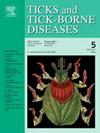丹麦蜱传脑炎病毒和土拉弗朗西斯菌地理分布的野生动物哨兵
IF 3.4
2区 医学
Q2 INFECTIOUS DISEASES
引用次数: 0
摘要
收集和检测蜱虫以监测罕见的蜱传病原体可能是一项劳动密集型工作,而且很难确定蜱虫中是否真正没有罕见病原体。然而,了解蜱传病原体的分布与风险评估和诊断是相关的。蜱传脑炎和兔热病是罕见的人类蜱传疾病。对这些疾病的病原体在丹麦的分布情况了解有限。本研究的目的是利用野生动物作为哨兵,评估蜱传脑炎病毒(TBEV)和土拉弗朗西斯菌的地理分布。采用酶联免疫吸附试验(ELISA)对2017 - 2023年丹麦各地区717种野生动物(305只狍、291只马鹿、107只小鹿、14只梅花鹿和64只貉)的血清和血浆进行了TBEV IgG抗体的筛选。阳性样本随后在病毒中和试验(NT)中进行检测。采用商业快速凝集试验对294只猪和67只貉进行了兔拉菌抗体检测。我们在犬中检测到TBEV NT的血清阳性率为0.6%,在貉中为1.6%,在犬中检测到土拉螺旋体的血清阳性率为6.8%,在貉中为16.4%。我们在丹麦的几个地区证实了该病毒的存在,并在西兰岛的新地区检测到抗体。此外,这是第一个间接探索丹麦土拉菌的地理分布的研究,我们确定了可能存在土拉菌的地区。本文章由计算机程序翻译,如有差异,请以英文原文为准。
Cervids and raccoon dogs as wildlife sentinels for the geographical distribution of tick-borne encephalitis virus and Francisella tularensis in Denmark
Collecting and testing ticks for rare tick-borne pathogen surveillance can be labour-intensive and true absence of rare pathogens in ticks is difficult to determine. Nevertheless, knowledge of the distribution of tick-borne pathogens is relevant for risk assessment and diagnosis.
Tick-borne encephalitis and tularemia are rare human tick-borne diseases. Knowledge of the distribution of the pathogens of these diseases in Denmark is limited. The aim of this study was to assess the geographical distribution of tick-borne encephalitis virus (TBEV) and Francisella tularensis using wildlife as sentinels.
Wildlife serum and plasma from 717 cervids (305 roe deer (Capreolus capreolus), 291 red deer (Cervus elaphus), 107 fallow deer (Dama dama), 14 sika deer (Cervus nippon)) and 64 raccoon dogs (Nyctereutes procyonoides) from all Danish regions, collected from 2017 to 2023, were screened for IgG antibodies against TBEV by using a commercial enzyme-linked immunosorbent assay (ELISA). Positive samples were subsequently tested in a virus neutralisation test (NT). A total of 294 cervids and 67 raccoon dogs were examined for antibodies against F. tularensis using a commercial quick agglutination assay.
We detected a TBEV NT seroprevalence of 0.6 % in cervids and 1.6 % in raccoon dogs and an F. tularensis seroprevalence of 6.8 % in cervids and 16.4 % in raccoon dogs.
We confirmed TBEV presence in several areas of Denmark and we detected antibodies in new areas of the island of Zealand. Furthermore, this is the first study to indirectly explore the geographical distribution of F. tularensis in Denmark and we identified areas with probable presence of F. tularensis.
求助全文
通过发布文献求助,成功后即可免费获取论文全文。
去求助
来源期刊

Ticks and Tick-borne Diseases
INFECTIOUS DISEASES-MICROBIOLOGY
CiteScore
6.90
自引率
12.50%
发文量
185
审稿时长
6-12 weeks
期刊介绍:
Ticks and Tick-borne Diseases is an international, peer-reviewed scientific journal. It publishes original research papers, short communications, state-of-the-art mini-reviews, letters to the editor, clinical-case studies, announcements of pertinent international meetings, and editorials.
The journal covers a broad spectrum and brings together various disciplines, for example, zoology, microbiology, molecular biology, genetics, mathematical modelling, veterinary and human medicine. Multidisciplinary approaches and the use of conventional and novel methods/methodologies (in the field and in the laboratory) are crucial for deeper understanding of the natural processes and human behaviour/activities that result in human or animal diseases and in economic effects of ticks and tick-borne pathogens. Such understanding is essential for management of tick populations and tick-borne diseases in an effective and environmentally acceptable manner.
 求助内容:
求助内容: 应助结果提醒方式:
应助结果提醒方式:


